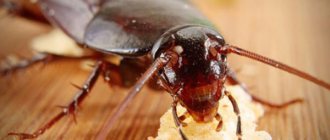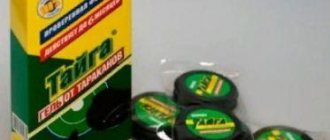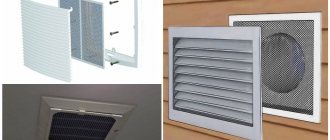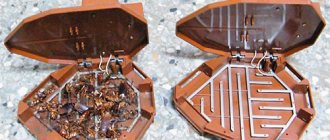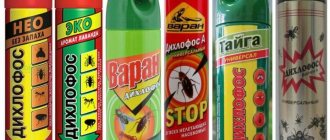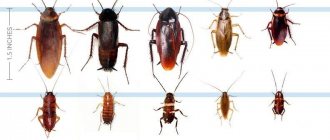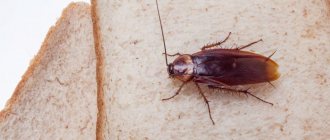The easiest way to get rid of cockroaches is to contact the sanitation service. However, the cost of professional treatment of an apartment does not seem justified for everyone. In addition, it is quite difficult to choose a good one over scammers. An alternative option to hiring exterminators would be to purchase a powerful insecticide and treat the apartment yourself. A professional cockroach repellent can be purchased in online stores or on sanitary service websites, and the review below will help you choose the most effective product.
Boric acid
I would like to start with one of the most effective folk remedies - boric acid.
Although it has been used to combat cockroaches since the end of the last century, it still remains the most optimal solution among non-specialized options. The uniqueness of boric acid is that cockroaches, which are famous for their vitality, have not been able to adapt to it. To combat cockroaches, boric acid is most often used in powder form, which is mixed with egg yolk. Then, bait balls are formed from the resulting “dough” and placed in the cockroaches’ favorite places. You can also add vanillin to the bait, which will attract insects.
Although boric acid is harmless to humans in small quantities, you should take precautions and wear gloves when working with it. You should also make sure that the balls are kept out of the reach of animals and children.
Cockroach extermination service
Why is it more convenient to order pest control rather than carry it out yourself? Professionals will perform the treatment with potent agents using special equipment and in a short time. The owner will only have to ventilate the apartment, do wet cleaning, and collect parasites with a vacuum cleaner. Contacting specialists is convenient:
- All premises are treated;
- when insects appear again, free disinfestation is carried out;
- A quality guarantee is provided for the work performed.
The cockroach extermination service offers to pre-prepare the premises to provide pest control services. It is necessary to remove food, cover equipment with cloth or cellophane, remove animals, remove unnecessary items from the room. Why are professional actions more beneficial when exterminating pests? Factors that are not always taken into account by customers play an important role:
- safety precautions;
- experience in exterminating insects;
- high execution speed;
- safety of drugs on pets and people;
- information on pest prevention.
How do disinfectants poison cockroaches?
When professionally treating premises, cockroaches are baited with special preparations. The choice of substance depends on the disinfection method. Effective means of destruction are:
- for cold fog - Xulat, Tetrix, Del-zone;
- for hot spraying – Fendona 1.5 SC, Sinuzan 48% e.e., K-Otrivin VG 250;
- for freezing insects - nitric oxide or freonite.
When sanitizing apartments, medical institutions, and industrial premises, disinfectants poison cockroaches with active chemicals that have a wide range of effects on insects. Effective products for professional pest control:
- Solfak;
- Chlorpimark;
- Fufanol Super;
- Cypertrin;
- Sychlor;
- Sinuzan;
- Minap-32;
- Lambda zone;
- Get.
Ammonia
Another equally effective folk method of fighting cockroaches is ammonia. Unlike boric acid, its task is not to harm the insect, but to scare it away. Cockroaches have an extremely well-developed sense of smell, so when they smell an unpleasant odor, they will try to avoid it.
To combat cockroaches, ammonia is diluted with water based on the proportion: one teaspoon of ammonia per liter of water. The resulting solution is used to treat “approaches” from which uninvited insects can come, for example, a gap under the front door or holes in a plumbing unit. The procedure is carried out every 2-3 days and is repeated until the cockroaches lose interest in your apartment.
Synanthropic cockroaches (order Blattoptera)
5.6. Synanthropic cockroaches (order Blattoptera)
5.6.1. Features of biology, epidemiological significance
Synanthropic cockroaches living in Russia are of imported origin and inhabit mainly heated premises. They are mostly polyphagous. About 60 species in different countries are associated to one degree or another with human habitation. The dominant species is the red cockroach - Blattella germanica (L.). The second place in number and prevalence is occupied by the black cockroach - Blatta orientalis L. Currently, American cockroaches - Periplaneta americana (L.), South Asian - Periplaneta australasiae (F.) and furniture cockroaches - Supella longipalpa (F) live in populated areas of Russia .). Ash cockroaches - Nauphoeta cinerea (Oliv.) were recorded in greenhouses and as single specimens in residential premises. Cockroaches of the genera Blaberus and Panchlora are sometimes imported with tropical fruits; There have been cases of importation of cockroaches of the genus Leucophaea, but these cockroaches do not take root in the temperate climate zone.
In a building infested with cockroaches, there is a local population of insects, consisting of separate groups and occupying a common area that satisfies their biological needs. When the population is high, cockroaches spread throughout the building; when the population is low, they live only in some rooms. The uneven distribution of insects in a building is associated with the presence or absence of favorable conditions for them: optimal temperature, moisture, food, shelter.
In multi-storey buildings, cockroaches form stable populations with a tendency to constantly expand the boundaries of the occupied territory due to the formation of new intra-population groups. The habitats of insects in each building and room are relatively constant. Cockroaches mark their shelters with odorous substances - pheromones (aggregation, sex), which attract these insects. The more suitable shelters for cockroaches, the higher the number of insects in each room and building. As the number of cockroaches increases and the shelters become overcrowded, some of the insects move into neighboring rooms and buildings. Cockroaches move at night or in the evening, leaving dispersal pheromone, as well as sex and aggregation pheromones on their paths, sometimes in large groups of several dozen or more individuals; in the warm season - along the street or along the outer wall of the house, and in cold times - along communication devices. First of all, cockroaches inhabit premises with optimal conditions for them: in hospitals - catering units, pantry-dispensing rooms, staff rooms, nurses' rooms, toilets; in children's institutions - catering units; in hotels there are catering facilities and bathrooms in the rooms. In food objects they can live in most rooms, because... they find all the conditions they need there.
The main part of the population (80 - 90%) consists of larvae. They hide in the narrowest crevices corresponding to their size, where they cannot be detected, and where insecticides do not penetrate during treatments. Therefore, during processing, mainly adult insects die - adults and large larvae of 5-6 instars. Small larvae of 1 - 4 instars that did not die during processing turn into adults and are capable of producing offspring in 2 - 3 months. In those rooms inhabited by cockroaches that were not treated, imagoes are also preserved. They continue to reproduce, and after 2 - 4 weeks. cockroaches are resettled from untreated premises to the territory freed from them.
The main difficulty in controlling cockroaches is that they multiply quickly and have an aggregated distribution indoors.
Due to the presence of “scout” cockroaches in the population, cockroaches actively explore new territories, choosing new territories to form secondary centers of settlement, bypassing “transit” zones, in which they do not linger due to unsuitable living conditions.
Information about the structure of specific populations of synanthropic cockroaches allows us to purposefully and effectively influence it in order to control and maintain its numbers at a safe level.
The red cockroach (Prusak) - Blattella germanica (L.) (family Blattellidae) is cosmopolitan. This species is native to northeastern Africa.
The ootheca appears in the fertilized female within several days, depending on the temperature, and usually develops completely within 24 - 48 hours. The period of development of larvae in the formed ootheca lasts 2 - 4 weeks. and may be longer depending on temperature. At an air temperature of 27 °C and a humidity of 45%, females shed ootheca after 22 days, and at 70% - after 21 days. Ootecae typically contain 37 to 44 eggs, and approximately 90% hatch into larvae. The female usually produces 3 - 8 ootheca (maximum - up to 10) during her life (6 - 8 months). The development of one generation of the red cockroach lasts 3–4 months, during which time the population size increases hundreds of times.
The larvae molt 5–7 times over a period of 30–60 days, depending on the temperature and amount of food. Nutrition and especially water play an important role in regulating the reproduction of cockroaches.
Adults usually live more than 100 days, but under favorable conditions this period can be much longer. A temperature of 30 °C is optimal for the existence of the species.
The species is usually found in kitchens, adjacent food storage areas, bathrooms, food processing plants, hospitals, ships and other places.
Red cockroaches can be found outdoors in natural habitats. In temperate climates in mid-winter, in outdoor garbage heaps. In summer, they can crawl along the outside of building walls. There is also a report of red cockroaches being found in refrigerators.
Red cockroaches are mechanical carriers of pathogens of intestinal infections. Eggs of whipworm, pinworms, roundworms and tapeworms were found in the rectum of the red cockroach. The bacteria Shigella boydii, Sh. dysenteriae, Staphylococcus aureus, S. epidermidis, Streptococcus faecalis, Vibrio sp. etc. Entamoeba histolitica cysts were found in the intestinal contents. The red cockroach is capable of crawling into the external auditory canal, causing severe irritation to the eardrum, and medical intervention is required to remove it. At night, while people sleep, cockroaches can partially or completely bite off the epidermis on the lips, elbows, neck, fingers, eyelids and other places (mainly in children and untidy people).
Red cockroaches, their excrement, and dry skins after molting can cause an allergic reaction in the form of dermatitis, bronchial asthma and rhinitis.
When they penetrate electrical appliances, cockroaches can cause damage to computers, televisions and other equipment, closing circuit board contacts and exposed wires with their bodies. There have been cases of damage to the plastic insulation of wires and the resulting short circuit.
Black cockroach - Blatta orientalis L. (family Blattidae). A relatively long-living species of cockroaches, under unfavorable nutritional conditions and temperatures, its development cycle can take more than two years, usually 5 - 13 months. Under optimal conditions 6 months. and less may be sufficient to complete the entire cycle. The lifespan of adults ranges from 3 to 8 months. Temperature optimum - 20 - 29 °C. The preferred habitat is the premises of the lower level of buildings: basements, cellars, sewers, cracks near drainpipes, space behind cabinets, inside walls, under floor coverings and in other places.
In Russia, during the warm season, black cockroaches can be found outside heated rooms: in garbage, under the bark of trees, under stones and leaves. In the southern regions, the larvae stop developing in winter when the temperature drops sharply, which explains the long larval period. Black cockroaches are polyphagous, but prefer foods rich in carbohydrates. Infection of black cockroaches with roundworm eggs has been noted. The bacteria Escherichia coli, Shigella boydii, Sh. flexneri, Sh. sonnei, Staphylococcus sp., Streptococcus sp., Micrococcus sp., Vibrio sp., Mycobacterium leprae and M. tuberculosis. Larvae of black cockroaches are noted as passive carriers of pathogens of avian tuberculosis and paratuberculosis.
The furniture (brown-bordered) cockroach - Supella longipalpa (F.) (family Blattellidae) is an almost cosmopolitan species. The distribution of the species in the temperate zone was noted in the 20th century.
Cockroaches of this species are capable of widespread distribution, similar to B. germanica, being inferior to red cockroaches in the rate of expansion in temperate latitudes due to their greater requirement for heat. The first information about the presence of S. longipalpa in Russia (Moscow) appeared in 1983.
The life cycle of the species is relatively short. Adults live from 90 to 115 days at 30 °C. Females are capable of laying 10–20 oothecae.
Furniture cockroaches live in the same places as red cockroaches. However, unlike the Prusak, they are not limited to the kitchen, but form clusters in bedrooms, where they hide in beds, chests of drawers, tables, linen closets, behind paintings, under wallpaper, etc.
Supella longipalpa prefers starchy foods, such as glue in books and under wallpaper. This ensures his successful settlement of buildings where food is not prepared. In the warmest parts of its range, S. longipalpa is a free-living species and can be found in almost any type of structure; it is also a mechanical carrier of pathogens of infectious diseases.
The American cockroach - Periplaneta americana (L.) (family Blattidae) is cosmopolitan. However, it is not distributed as far north as the Prussian. Large cockroaches, the adult of which reaches 35 - 40 mm in length. Under unfavorable conditions, cockroaches can live for about 100 days. Under favorable conditions, the life expectancy of the imago is 2 - 3 years. The female produces an ooteca every 4 - 10 days. One female is capable of laying 10 - 90 (on average - 21 - 59) ootheca containing 16 eggs. The incubation period of eggs lasts 35 - 40 days (sometimes 24 - 100 days). The larvae molt 7–13 times over 5–15 months. Their preferred temperature is about 28 °C, but they are active at 21 - 33 °C.
They live in food factories, warehouses, bakeries and other places with accessible food. They are sometimes found in residential kitchens, toilets and sewage systems. In temperate climates during the summer they can live in garbage and landfills. The bacteria Enterobacter aerogenes, Escherichia coli, Mycobacterium avium, M. gordonae, Salmonella (3 serotypes), Shigella boydii, Sh. dysenteriae; Giardia cysts, Toxoplasma, etc. Mutagenic and carcinogenic compounds (tryptophan derivatives, xanthurenic and kynurenic acids, etc.) were found in the excrement of cockroaches. American cockroaches can cause an allergic reaction in the form of dermatitis, bronchial asthma and rhinitis.
The South Asian cockroach - Periplaneta australasiae (F.) (family Blattidae) is widespread in tropical and subtropical regions of the world.
The life span of the imago is probably 4 - 6 months. The female can produce about 20 - 30 ootheca with an interval of about 10 days. The incubation period of eggs is about 40 days. Each ootheca contains 20 - 24 eggs. The period of development of larvae lasts 4 - 12 months. depending on conditions. The number of molts is from 9 to 12. The species prefers warm and humid places and lives in houses and other buildings similar to those of P. americana. Able to live in greenhouses, where it feeds on plants.
The bacteria Salmonella antis, Mycobacterium leprae, etc. were isolated from the body of South Asian cockroaches.
Ashy cockroach (cancer cockroach) - Nauphoeta cinerea (Oliv.) (family Blaberidae) is a tropical insect, a free-living species.
One female is capable of producing more than 20 ootheca, each ootheca containing 26 - 40 eggs (average 33). The larvae have 7 - 8 molts over 87 - 94 days at a temperature of 30 - 36 °C. A characteristic feature of the behavior of newly hatched larvae is that they remain under the female for an hour, after which they move on to independent life.
These insects are recorded in ports, warehouses, and external extensions of houses. Greenhouses are ideal habitats in temperate zones. The bacteria Salmonella typhimurium, S. paratyphi, etc. have been isolated from the body of ashen cockroaches. Ash cockroaches can also cause an allergic reaction in the form of dermatitis.
5.6.2. Disinsection measures
5.6.2.1. Sanitary and preventive measures
Aimed at reducing the number of places suitable for cockroaches to live and breed, i.e. to localize the “hotbed” in a limited area, as well as to prevent the introduction of these insects into the building.
It is necessary to systematically carry out sanitary and educational work at contract sites and among the population to comply with measures to prevent the infestation of premises by cockroaches, to train the population in the proper organization of insect control and methods of using insecticides.
5.6.2.2. To increase the effectiveness of the fight against cockroaches, it is necessary to carry out minor repairs in the premises in a timely manner, sealing gaps and cracks, especially in walls covered with tiles; During daily cleaning, eliminate clutter in all rooms. Thoroughly rinse or clean areas where clusters of cockroaches have been found. Do not cover the walls with decorative paneling and do not install suspended ceilings in rooms where cockroaches can breed.
5.6.2.3. Food waste should be collected in specially designed containers (tanks, buckets, etc. with closing lids) and emptied daily. Water taps must be kept closed, especially at night; Bathrooms and washbasins are dry. Do not leave food and food scraps overnight in residential and office premises, in playrooms of children's institutions, in residents' and nurses' rooms in hospitals, etc. In hospitals, patients' personal food products should be stored in refrigerators. In those wards where cockroaches have been found for a long time, it is recommended to use open tables instead of closed bedside tables.
5.6.2.4. In food production, the surfaces of technological equipment and tools that come into contact with products should be mechanically cleaned daily and washed with hot water as necessary.
5.6.2.5. It is necessary to carefully inspect the cardboard, plywood and wooden packaging of products and property coming from stores, warehouses, and bases. If cockroaches are detected, containers with non-food products are treated with an aerosol can or other fast-acting preparation, containers for food products are treated with hot water. The supplier must be notified of the contents of the package.
5.6.2.6. Regular control surveys must be carried out by organizations that have business agreements for the maintenance of these facilities. They are an obligatory element in the system of fighting cockroaches both in the cleared area and in the area inhabited by cockroaches. The purpose of control surveys is: timely detection of cockroaches in premises, identification of their habitats, organization of extermination measures when the population is low to prevent the spread of insects, prompt assessment of the effectiveness of the measures taken. Scheduled inspections in each building are carried out at least once a month. If extermination measures are also carried out in the same month, then it is necessary to inspect the structure the next day after treatment to fully identify the habitats of insects. Buildings that have been infested with cockroaches for a long time are inspected by disinfection instructors, disinfection doctors or biologists.
5.6.2.7. It is recommended that the results of control be registered by specialists of organizations carrying out processing, recording all activities carried out during the year. In multi-storey facilities (hospitals, hotels, etc.) serviced under a contract, there must be special notebooks in which the appearance of cockroaches in the premises is recorded. These records are additional information when organizing extermination activities.
5.6.2.8. To identify the habitats of cockroaches, means are used that provoke the insects to come out of their shelters (aerosols from aerosol packages). Monitoring and examinations carried out in the evening are more effective; survey of persons present in the premises, especially in the evening and at night; placement of glue traps in the form of cardboard houses with food attractants and (or) pheromones. To count the number of cockroaches before and after treatment with insecticides, glue traps should be installed throughout the room at different heights in different places (on the floor, on shelves, in cabinets, in desk drawers) at a rate of 3 - 5 pieces. for 10 sq. m area. Counts of caught cockroaches are carried out every 1 - 2 days. More cockroaches will be caught in traps located closer to the localization sites or routes of movement and penetration of insects into the room. For censuses, you can use 0.5-liter glass (plastic) containers with food bait. A small piece of bread soaked in beer or sunflower oil is used as bait. The top of the jar from the inside is smeared with a thin layer of Vaseline to prevent cockroaches that get into the jar from crawling out. Traps are placed close to possible habitats of cockroaches.
5.6.2.9. Places to be examined during the inspection: cracks and cracks in constantly heated places, near sources of moisture, around sinks, in facing tiles, electric motors, behind electrical panels, electrical wiring, refrigerators (in motors and rubber gaskets), gas stoves, cabinets, shelves, behind radiators heating (in winter), under digesters and behind their casing, dishwashers, bathtubs and other equipment; hollow legs of cutting tables, bedside tables in hospital rooms, table drawers, door frames, wardrobes, etc.
5.6.3. Extermination activities
Extermination measures are the destruction of insects at a facility or a sustainable reduction in their numbers to the level of single insects through systematic disinfestation.
5.6.3.1. Extermination measures must be targeted, i.e. carried out only in those premises in which cockroaches were found in the current or previous month. It is not advisable to apply the drug to the walls and baseboards around the perimeter of each room. It is necessary to actively identify and treat habitats and accumulations of insects, both during selective and complete treatment of all premises of the building.
5.6.3.2. All rooms infested with cockroaches in one building are treated simultaneously (in one day) or for 2 to 4 days in a row. At longer intervals, disinsection is ineffective.
5.6.3.3. Treatment with contact insecticides of all rooms or floors in a multi-story building should be carried out if at least 30 - 50% of the rooms (depending on the characteristics of the facility) are inhabited by cockroaches. Such an event is permissible only during a sanitary day, repairs, or in cases where it is possible to ensure that there are no people in the treated premises for 24 hours after treatment (in hospitals, hotels). The purpose of continuous treatment is to sharply reduce the high number of cockroaches, after which regular targeted exterminatory selective treatments are required.
5.6.3.4. With a low number of cockroaches, regular extermination measures ensure effectiveness after 1 - 2 months, and with a high number and widespread distribution of insects, especially in multi-storey buildings, only after monthly treatments for 3 - 6 months.
5.6.3.5. The frequency of extermination measures depends on the category of the building and the degree of cockroach infestation. In food facilities, in the catering departments of institutions, where in most premises there are favorable conditions for the habitation and reproduction of cockroaches, as well as in “built-in” facilities, if there is a possibility of insects migrating into them from neighboring premises, treatments are carried out once a month, regardless of the degree of their infestation by cockroaches. In children's institutions, medical institutions, hotels, etc. The frequency of treatments in all premises, except for catering units, can be from 12 to 4 times a year, depending on the degree of cockroach infestation.
5.6.3.6. Extermination measures are necessarily accompanied by control, in which the persons who carried out the treatment identify the inhabited premises and habitats of insects, note which premises were treated, and the degree of their infestation with insects. Particular attention is paid to premises where cockroaches have been repeatedly found. Depending on the degree of population, the approximate period of subsequent processing is determined.
5.6.3.7. Treatments based on one-time requests are only advisable when the number of cockroaches is low. When the population is high in multi-storey buildings, one-time treatments based on one-time applications are ineffective; in these cases, it is rational to carry out regular control and extermination measures.
5.6.3.8. The most effective are combined treatments with liquid agents and dusts (powders) with a long residual effect. Powders are used to treat spaces behind decorative wall cladding, hidden dry places, electrical wiring, and electric motors (when not working). Liquid preparations or gel-like pastes and gels - bottlenecks, cracks, crevices behind baseboards, in facing tiles, etc. The effectiveness of treatments increases if within 10 - 15 minutes. Before using contact preparations, provoke cockroaches to come out of their hiding places using aerosol products.
5.6.3.9. Currently, populations of synanthropic cockroaches and, first of all, red cockroaches, resistant to the contact insecticides used, are widespread. To destroy such populations, as well as in cases where it is undesirable to treat surfaces with insecticides, poisoned food baits are used in the form of gel-like pastes and bait stations that have an intestinal-contact effect. The use of baits is especially effective in combating cockroaches in areas where food products are not available. It is advisable to place bait stations and glue traps only near the cockroach habitat. In a crowded, cluttered room, the use of these products is ineffective.
5.6.3.10. As a means of reducing the number of cockroaches, it is necessary to use drugs that influence the spatial structure of the population, help reduce physical activity, localize groups and prevent the expansion of the boundaries of their habitat: bait stations with insect development regulators (ISH, AYUG), avermectins, disk- fumigator with AYUG, hydroprene, etc.
5.6.3.11. In trenches of underground technical communications, incl. city sewerage, in case of large numbers, contact-acting preparations are used.
5.6.3.12. To kill cockroaches, contact and intestinal insecticides are used: organophosphorus compounds, carbamates, pyrethrins, pyrethroids, inorganic acids (boric acid), inorganic salts (borax), amidohydrazones (hydramethylnon), neonicotinoids (imidacloprid, thiamethoxam, acetamiprid), sulforamides, phenylpyrazoles ( fipronil), avermectins (avermectin C, abamectin (avermectin B)), etc.
5.6.3.13. It is necessary to periodically determine the level of sensitivity of cockroaches to the insecticides used in order to promptly rotate drugs and change the tactics of extermination measures (section 6.4).
5.6.4. Evaluating the effectiveness of activities
5.6.4.1. The effectiveness of measures to combat cockroaches depends not only on the quality of the disinfestation carried out, but also on the implementation by the administration of the serviced facility of regulations aimed at increasing the efficiency of disinsection.
5.6.4.2. During a monthly control inspection, buildings or “built-in” objects are considered free from cockroaches if insects are not detected within a month by any of the control methods in any of the premises.
5.6.4.3. If one or more live cockroaches are detected, the occupied premises are treated. The structure is transferred to the “inhabited” category if living insects are discovered again in the next month.
5.6.4.4. Additional indicators of the effectiveness of disinsection in long-term or periodically occupied buildings are the number of premises infested with cockroaches and the presence of detected clusters or individual insects. These indicators characterize the degree of population of a building by cockroaches and affect the frequency of extermination measures carried out in them.
5.6.4.5. The cockroach infestation of a building (or “built-in” facility) is considered high if individual insects and their clusters are found in more than 20% of the premises. A cockroach infestation is considered low if single insects are found in less than 20% of the premises of a building (or “built-in” facility).
5.6.4.6. Buildings newly received for service must be free of cockroaches within two months. The exception is multi-storey buildings and “built-in” objects, where systematic extermination measures must be carried out over a longer period.
5.6.4.7. The absence of cockroaches in all areas of the building is one of the indicators that determines the assessment of the sanitary condition of the institution.
Table of contents
1 area of use
2. Regulatory and methodological documents
3. Conventions
4. Terms and definitions
5. Characteristics of individual orders and the most common species of arthropods in the Russian Federation (main features of biology, ecology, epidemiological significance, control measures, assessment of the effectiveness of measures)
5.1. Lice (order Anoplura, family Pediculidae and Phthiridae). Pediculosis
5.2. Fleas (order Siphonaptera)
5.3. Blood-sucking dipterous insects (mosquitoes, midges, midges, horse flies, mosquitoes)
5.4. Bed bugs (order Hemiptera, family Cimicidae)
5.5. Synanthropic flies (order Diptera, suborder Brachycera Cyclorrhapha - short-whiskered-round-stitched)
5.6. Synanthropic cockroaches (order Blattoptera)
5.7. Ants (order Hymenoptera - hymenoptera, family Formicidae)
5.8. Wasps (order Hymenoptera - hymenoptera, family Vespidae - folded-winged wasps)
5.9. Order Parasitiformes
5.9.1. Ixodid ticks (family Ixodidae)
5.9.2. Argasid mites (family Argasidae)
5.9.3. Rat ticks (family Macronyssidae)
5.10. Order Acariformes
5.10.1. Scabies mites (family Sarcoptidae)
5.10.2. House dust mites (family Pyroglyphidae)
5.10.3. Red mites (family Trombiculidae)
6. Disinsection measures
6.1. Preventive actions
6.2. Extermination activities
6.3. Individual protection of people from attacks by blood-sucking insects and ticks
7. Resistance of arthropods to insecticides (criteria that determine the tactics of disinfestation work)
8. Organizing, planning and carrying out pest control activities
9. Disinsection measures in objects of various categories
9.1. Institutions, organizations, enterprises and facilities where preventive and exterminatory measures should be carried out
9.2. Disinsection activities carried out in open areas
9.3. Rules of behavior for people when staying in an area dangerous with regard to tick-borne encephalitis and other infections caused by ixodid ticks
9.4. Disinsection measures in foci of vector-borne infections
10. Safety measures during disinfestation
11. First aid measures for insecticide poisoning
12. Criteria for assessing the safe use of pest control agents
13. Equipment used when carrying out pest control work
Annex 1
Appendix 2
Appendix 3
Appendix 4
Appendix 5
Appendix 6
Appendix 7
Appendix 8
Appendix 9
Appendix 10
Appendix 11
Appendix 12
back to contents
Freezing
As a “nuclear strike” in the fight against cockroaches, one can consider one of the oldest and most controversial methods - freezing. As you might guess from the name, this method of control involves reducing the temperature in the room to near-zero or negative values. The fact is that cockroaches, like other insects, cannot warm themselves, and therefore are not able to withstand such frosts.
This method is used only in winter. To do this, open the windows and closet doors to allow cold air to reach every crack. However, before you start freezing, you need to turn off the central heating to avoid bursting the pipes. The apartment remains in this form for about 4 hours.
The only problem with this method is that with a high degree of probability it can result in damage to the water supply or household appliances. And if you forget to turn off the heating, then so do the batteries. Therefore, this method should be resorted to only in extreme cases.
The work procedure of professional exterminators
When ordering a disinfestation service, the time of arrival of specialists is agreed upon with the client, and in addition, recommendations are given on how to prepare the premises for the procedure.
The arriving exterminator preliminarily inspects the premises, determines the degree of infestation and selects the most optimal type of treatment. There are several methods:
- manual (the insecticide is sprayed using an electric or mechanical sprayer);
- processing with a cold or hot fog generator;
- barrier (in places where insects can penetrate, a protective layer of gel is applied).
Fog
The specialist also decides on the spot what exactly to poison cockroaches with, based on the chosen treatment method.
An employee of the pest control service provides the owner of the apartment with a contract, certificates for the drugs used, a receipt for payment, after which he puts on a protective suit and begins processing. The owners leave the premises before starting the procedure. If one of the household members decides to control the process, he should also wear protective clothing and a mask.
Poisoning of cockroaches begins in the kitchen, bathroom and hallway. First, the places where insects are most likely to be found are sprayed, namely technical risers, the space under the sink, under the bathtub, behind the refrigerator and kitchen cabinets, baseboards, and the back walls of furniture. Then the walls and floor are sprayed. After this, a similar treatment of living rooms is carried out.
Gels
From folk remedies we will smoothly move on to the achievements of modern technologies. One of them is special gels that are applied in the habitats of cockroaches. Having touched such a gel, the cockroach becomes a carrier of the poison, spreading it throughout the colony on its paws. After some time, the gel begins to act and destroys the insect.
Although gels generally do not have an unpleasant odor and do not release toxic substances, they are extremely dangerous for humans and pets. Therefore, they should be applied only in places inaccessible to children and pets, for example, behind a kitchen unit.
Where do cockroaches come from in catering kitchens?
This question can be answered like this - from everywhere. If you do not take action, cockroaches in the kitchen of a canteen, cafe or restaurant are almost inevitable “guests”. Having settled near water, food and in warmth, cockroaches begin to multiply at hurricane speed. There is no need to explain why insects are harmful:
- spoil food;
- leave traces of life activity everywhere;
- are carriers of diseases dangerous to humans.
Neighborhood with pests causes physical and aesthetic inconvenience. But cockroaches can appear from anywhere:
- From the street. Small parasites enter the kitchen even through the slightest cracks, “arrive” on the shoes and clothes of guests, with boxes of food, etc.
- From the neighbors. If a canteen, cafe or restaurant is located in a residential building or shopping center, cockroaches will come running from the neighbors.
- Through ventilation pipes, sewerage, air ducts, with furniture and textiles.
Having appeared in the kitchen, cockroaches settle in all dark and light corners. They can be found on table surfaces, in cabinets, under tables, behind stoves and refrigerators.
If the cleaning of the premises is carried out poorly, traces of food remain in the corners and on the shelves, cockroaches will definitely appear in the kitchen. You may not see them, but they are there!
And even a one-time general cleaning does not solve the problem. Cockroaches can go without food for up to 1.5 months. But after 2 days they die without water. A drop of moisture is enough to feed a whole brood of pests, so it is important to wipe all surfaces dry.
Crayons
An alternative to gels are specialized crayons, which are used to draw thick lines in places favored by cockroaches, for example, behind furniture. If a cockroach crosses such a line, it will contain an insecticide that will kill the insect in a few hours.
It is recommended to use crayons once every couple of months, remembering to erase old lines first. When working with them, you must follow safety rules and use protective equipment: masks and gloves. Cockroach crayons are also toxic to humans. Therefore, this product should not be used if there are small children or pets in the house.
Why is it necessary to exterminate cockroaches?
It is a misconception to think that insects appear only in unscrupulous owners. They can come crawling from neighbors, appear with new furniture from the store, or arrive in a suitcase from vacation. The danger of their arrival is that one female can produce up to 300 cockroaches in a month. Insects require water to exist, but they can eat anything, including paper and garbage.
Why is it necessary to exterminate cockroaches? It’s unpleasant when they crawl around the apartment, leaving black dots everywhere with a nasty smell. The main reasons for exterminating parasites are their capabilities:
- carry infectious diseases;
- spoil food;
- provoke skin pathologies;
- spread harmful bacteria, worm eggs;
- disrupt the operation of household appliances;
- endanger small children;
- provoke allergies.
Ultrasound generators
One of the latest technologies in the fight against cockroaches is ultrasonic repellers, which make the room unsuitable for insect life. Moreover, in most cases they are completely safe for humans.
Prices for such equipment start from several hundred rubles, but I do not recommend buying the cheapest models. Unfortunately, there are a huge number of fakes on the domestic market, the housing of which does not even contain a source of ultrasonic waves. Therefore, such repellers should be purchased only in trusted stores, after reading reviews about the selected model.
Causes of cockroaches
Of the five thousand species, red cockroaches appear most often near humans. These are mobile insects that are active at night. Thanks to their flat body, they hide in crevices and are almost invisible during the day.
Prussians appear in apartments for various reasons:
- Moving from a neighboring apartment;
- They are carried in bags that have been standing for some time in rooms with cockroaches;
- They get caught with things bought at the market or secondhand.
Leftover food, garbage, water are suitable conditions for the rapid reproduction of insects. One female gives birth to an average of 40 individuals at a time. And reproduction continues throughout the year.
Aerosols
Aerosols are often recommended as an instant remedy for cockroach control. However, their main disadvantage is high toxicity and spread through the air. For this reason, you can only work with aerosols to combat cockroaches while wearing a respirator. At the same time, there should be no pets, children or people without protective equipment in the apartment. After using the aerosol, the room must be thoroughly ventilated and extensive cleaning carried out.
Professional remedies for cockroaches: rating of the best drugs
It’s worth mentioning right away that insecticides on the market are predominantly “soft” preparations of contact-intestinal action.
Household poisons belong to hazard class 3-4 (moderately dangerous and low-hazardous). Only professional SES services can use potent agents of hazard class 1 and 2, after conducting a thorough analysis of the contaminated premises and taking protective measures. The best remedies for cockroaches in an apartment or house, which can be used in independent control, were selected based on reviews from experts and consumers.
Primitive traps
You probably noticed that almost all of the above methods have restrictions for use in apartments where there are children or animals. For those who have exactly this situation, ordinary glue traps are perfect. Once caught in such a trap, the cockroach will no longer be able to get out.
At the same time, I want to note that we are talking about the simplest traps, which do not contain insecticides or anything else capable of destroying the insect. Of course, such a remedy can hardly be called highly effective. However, planned reduction of the cockroach population works almost flawlessly in the long term.
Note! If you have large black cockroaches, then select traps based on their size. Cockroaches simply cannot get into some of them.
To summarize, I would like to draw your attention to the fact that cockroaches primarily settle in places where there is dampness, food sources, for example, unwashed dishes, and many hidden places. Therefore, before you run to the store for one of the above products, do a thorough cleaning of your house and get rid of the excess. It is quite possible that this will be enough.
Methods of disposal
For a comfortable life, cockroaches need water, food and warmth. These are the factors worth influencing.
First of all, limit access to food: cover the trash can, sweep and remove all crumbs from the table and floor, and store all edibles in an airtight container.
Next, you need to block the paths to the liquid: wipe all puddles and condensation from the pipes, eliminate leaks, close the drain holes.
However, it is unlikely to be limited to such methods, and one cannot do without toxic substances and repellents. Here you can use purchased products or turn to folk experience.
One of the proven products that can be easily purchased in a store or online is the GEKTOR bait gel. She looks like this:
If the number of unpleasant neighbors exceeds reasonable limits or none of the methods help eliminate them, then it is better to contact a special organization. Disinfectors will treat your home with a professional poison and, with a high degree of probability, will save you from trouble for a very reasonable fee.
Traditional methods
People have been trying to get rid of these parasites for a long time, and therefore an extensive database of recipes has accumulated to solve the problem.
Interesting video on the topic.
Freezing
By removing access to drinking and food, you can deprive the Prussians of warmth in winter. Freezing is used for destruction.
Turn off the heating system, open all windows and doors wide and allow the apartment and everything in it to freeze.
For the creatures to die, the temperature must drop to -10 degrees Celsius and remain this way for at least three hours.
This method is difficult to implement in a city apartment, since individual heating in such rooms is still rare.
In addition, it is difficult to qualitatively reduce the temperature here. Nothing will prevent some of the insects from hiding deeper in the ventilation, hiding in holes on the warm wall, and returning when the procedure is completed.
But in a private home or country house, such an event can be quite effective.
Homemade traps
Help reduce the population. They are placed in places where parasites are concentrated: under the sink, near the trash can, under cabinets, near the ventilation hole. They will have to be checked frequently, freeing them from dead individuals and renewing the bait. These effective methods are recommended.
- Adhesive tape – double-sided tape should be attached to the cardboard. You can drop sweet syrup, jam or honey into the middle to attract barbels.
- Jar with bait - you need to pour beer or something sweet into a half-liter jar, and grease the walls with Vaseline or vegetable oil so that the reptiles do not get out.
- Plastic bottle - you need to cut off the neck of the container, turn it over and insert it into the lower part to form a kind of funnel. The delicacy placed at the bottom will lure gluttons, but they will not be able to crawl back out.
The results will be better if you set several traps at once.
Be sure to remove all edibles! Otherwise, the cockroaches will not covet the treat in the trap.
Poison
There are proven substances that cause longhorned beetles to die when eaten. This is for example:
- boric acid - so that the insects eat the poisonous drug, it is better to make a special “delicacy”. The powder is mixed with boiled egg yolk or potatoes, rolled into balls and laid out along the route of the insects;
You can make a mixture of borax with sugar or vanillin.
- Pyrethrum is pureed chamomile inflorescences. It must be handled in the same way as in the previous method - make poisonous balls.
Repellers
Prussians have a developed sense of smell, and therefore do not like strong odors. This can be used against them in order not to let them under your roof and create uncomfortable conditions for those already settled. For this purpose the following are used:
Essential oils – lemon balm, eucalyptus, geranium, lemongrass, lemon tree seed. Oil is used to lubricate drain holes, edges of trash cans, and surfaces near cracks in floors and walls. You can add a couple of drops to water and wipe all the shelves in the kitchen with the composition. And cotton pads soaked in aromatic composition can be placed in the ventilation hole to repel scout cockroaches.
Plants – You can use live plants in pots, such as geraniums or mint. It would be nice to hang bundles of dried herbs around the room.
Ammonia - dissolve a small amount of ammonia in water and wash the floors as usual. The smell will soon disappear, but a small concentration will still remain and will repel parasites. If there are already uninvited tenants in your house, then it is advisable to do this every time you clean. For prevention, this procedure should be carried out periodically.
Vinegar – all surfaces are treated with a solution of acetic acid, and you can use a sprayer to go over the walls. A significant disadvantage is the persistent aroma of vinegar, which does not dissipate for a long time.
Kerosene and turpentine are a desperate method, since not only insects, but also people suffer due to the unpleasant and pungent odor. When using kerosene and turpentine, it is recommended to leave your native place for several days. To make a repellent mixture, you need to mix kerosene and turpentine and coat all baseboards, cracks, areas under the bathtub and near the trash can. After a couple of days, it is advisable to repeat the procedure. After fixing the problem, you need to do some general cleaning.
Special means
Folk recipes are, of course, good, but often they do not bring the desired result and do not allow you to completely get rid of the dominance of voracious creatures. Specially developed chemicals are much more powerful.
The form of release of such chemicals varies:
- Gel – has a rather liquid consistency, which thickens over time. Gels are applied with a dotted line at points of accumulation and along the route of cockroaches. They are convenient to apply due to the fact that they are packaged in syringes and tubes. The price of such compositions is usually low, and they give a good effect.
- The paste is similar in consumer qualities to the gel, but is characterized by a slightly different consistency.
- Powder is not the best option if it is not possible to leave your home for a while, since in the process a suspension is formed that enters the lungs of people and pets. And it’s not far from poisoning. There are drugs that are diluted in liquid: they are safer and more convenient.
- Chalk is a compressed powder impregnated with an insecticide solution. They need to outline all the surfaces the cockroaches love. The insects eat the chalk and soon die. This product costs a penny, but it successfully copes with the problem.
- Spray is the most practical form, since it can be used to deliver poison even to the most inaccessible places. Cockroaches die quickly, and you can even spray the composition directly onto the insect.
- Trap - above we already touched on the topic of traps and talked about homemade devices. You can also buy ready-made ones. Their operating principle is the same: to lure parasites inside and prevent them from getting out.
Be prepared for the fact that you are unlikely to be able to get by with just one product. Most likely, a whole range of measures will have to be applied. And more than once. For example, poison the main part of the colony with an aerosol, lure survivors into a trap, or treat them with poisoned gel. And to scare away those who survived even after such measures, you can use ammonia and essential oil.
There are also ultrasonic repellers on sale that reproduce sound at a frequency inaudible to humans. But cockroaches hear him perfectly well, and they don’t like him.
If the colony is small and there are no other conditions for a happy existence, then the survivors can pack their bags and go in search of a better life. This method will also help prevent new uninvited tenants from moving in after bullying.
At whose expense?
Sanitation of cockroaches in common areas: basements, garbage chutes, stairwells is the responsibility of the management company. Moreover, you won’t have to pay anything extra, because cockroach disinfestation is included in the tariff. The management company (management company) must regularly take measures against cockroaches, as well as ensure good sanitary condition of the house - a dry basement, a clean garbage chute.
If insects appear at the entrance of your house, you need to write a statement to the Criminal Code with a complaint about the quality of the services provided. An answer about the timing of disinfection must be given within 3 days from the date of receipt of the application. If you have not received a response to your application, feel free to contact Rospotrebnadzor. In this case, based on the results of the inspection, not only will the house be treated, but the negligent management company will also be punished.
But getting rid of insects that have already made their way into the apartment is the responsibility of the owners of the premises. It is better if disinfestation is carried out simultaneously with the entrance, this will significantly increase the efficiency of treatment.
How to choose a reputable pest control service
- The most difficult thing when ordering pest control services is choosing a reliable and conscientious company. In large cities, this is especially difficult to do, because there are a lot of different organizations that are engaged in professional pest control of premises. Of course, there are also unreliable organizations that deceive their clients. We list the basic rules that will help you avoid running into such companies:
- Pay attention only to large companies that have several branches in other cities. Such companies usually do not inflate prices.
- Read people's reviews of the company on its website.
- When you call the service, check with the employee whether they have certificates for the products used and a license for the work performed. Ask the employee to bring them with him.
- Check whether the organization enters into an agreement with the customer and whether a seal is placed on it. If this is not the case, then it is better to contact another company.
- Also, when calling the disinfection service, find out if they can treat the premises using hot fog technology. Unreliable companies usually do not have the funds to purchase expensive equipment to use this technology. This means that it is better to avoid such services.
- Ask the manager if household members and pets are allowed to be in the home during the treatment. If he gives a positive answer, you should look for another service.
When the service has already arrived at your home, we recommend that you follow the following rules:
:
- Immediately ask the employee for all the necessary permits.
- Look at the contract and make sure that it bears the company's seal and clearly states the terms of the guarantee.
- Check the pest control product itself and compare its name with the certificate.
- Try to control all the work being carried out (of course, wearing personal protective equipment). Pay attention to how long it takes the specialist to process the room and how carefully.
- Pay money for pest control services only after it is completed and only when you see the result.
Preparing the premises
So, an organization that can be safely trusted to treat your apartment for cockroaches has been selected. Now we need to prepare the premises for the arrival of her employees. Our task is to protect products and belongings and simplify access to places where insects accumulate as much as possible. To do this you need:
Often, an apartment is treated for cockroaches after the arrival of a specialist, who assesses the scale of the work and leaves recommendations on how to prepare the room.
What drugs do pest control services use in their work?
As mentioned above, insecticidal agents are sprayed by professional services using special equipment.
These devices transform the drug into a finely dispersed substance that gets into the most inaccessible places, cracks and holes. In just 2-3 hours, the main (and sometimes the entire) population of cockroaches dies. Such insecticidal pesticides are those that are approved for use only by specialists. It is because of this that they are usually sold in volumes of one liter or more. Let's list the most popular: “Avicin”, “Xulat”, “Sinuzan”, “Tetrix”, “Averfos”
and others. From these concentrated preparations, the service worker prepares a working solution, diluting them in water.
To spray the working solution throughout all rooms, the following technologies are used
:
- Spraying the composition using a conventional hand sprayer
is the most easily accessible, simple and at the same time unproductive method. When implementing it, it is necessary that spraying occurs painstakingly and thoroughly, affecting all surfaces in the apartment, as well as cracks, holes and other hard-to-reach areas. - Treatment of rooms using “cold” fog
- the working solution in a specially electric generator first turns into a thin layer of fine aerosol, and then, mixed with air, is sprayed throughout the room and settles on all surfaces, and also gets into all kinds of pest habitats. - Treatment of premises using “hot” fog technology
- this method is similar to the “cold” fog method, but unlike it, the solution in the generator heats up greatly. Due to the heated state, the solution particles stay in the air longer, are smaller in size and slowly settle on various surfaces of the room. This technology is almost never used in small houses and apartments. This method is more suitable for homes with a large area or for industrial premises.
In those places through which cockroaches can enter the apartment, the exterminator sprinkles insecticidal powder or installs bait stations. He can also place a glue trap in these areas or lubricate the floor with a toxic chemical in the form of a gel.
Cleaning after treatment
After treatment, you need to wait the time necessary to kill the insects. The exterminator will call it for you, usually from 2-3 hours to 12. Then the apartment must be ventilated for at least an hour.
After ventilation, the cockroaches are disinfected. It consists of thoroughly wet cleaning all surfaces that come into contact with food or human skin. The floor is washed, leaving the baseboards and a few centimeters next to them dry. It is recommended not to touch other surfaces for 10 days, and hard-to-reach places for up to 3 weeks. Items that have been processed must be washed and the dishes thoroughly washed.
Source


